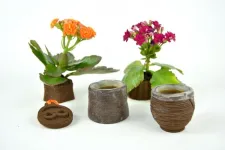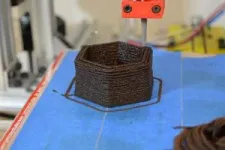(Press-News.org) Coffee can do a lot of things: Wake you up, warm you up and lessen that existential dread. According to a new study, it could also help reduce the waste from 3D printing.
That’s the vision behind a new project led by Michael Rivera, an assistant professor in the ATLAS Institute and Department of Computer Science at the University of Colorado Boulder. He and his colleagues have developed a method for 3D printing a wide range of objects using a paste made entirely out of old coffee grounds, water and a few other sustainable ingredients.
The team has already experimented with using coffee grounds to craft jewelry, pots for plants and even, fittingly, espresso cups. The technique is also simple enough that it will work, with some modifications, on most low-cost, consumer-grade 3D printers.
“You can make a lot of things with coffee grounds,” Rivera said. “And when you don’t want it anymore, you can throw it back into a coffee grinder and use the grounds to print again.”
The group presented its findings this summer at the Association for Computing Machinery’s Designing Interactive Systems conference in Pittsburgh.
For Rivera, the project is part of his mission to make 3D printing more sustainable—allowing artists, designers, engineers and more to quickly make graspable prototypes and other household objects without adding to landfills.
“Our vision is that you could just pick up a few things at a supermarket and online and get going,” Rivera said.
Good ideas come from caffeine
That vision predictably began in a coffee shop.
When Rivera was a graduate student at Carnegie Mellon University, he often worked out of a café in Pittsburgh called Arriviste Coffee Roasters. The coffee shop contracted with a local group to pick up its used coffee grounds for composting, but during the COVID-19 pandemic, that wasn’t possible. The waste began to pile up.
“The owner told me, ‘I don’t know what to do with it. So I just throw it away,’” said Rivera, who joined CU Boulder as a postdoctoral researcher in 2022. “I looked at the grounds and said, ‘Maybe I can do something with them.’”
Rivera explained that most consumer 3D printers on the market today print with thermoplastics of some kind. The most common is polylactic acid, or PLA. This material is, theoretically, compostable, but only a fraction of composting facilities will accept it.
“If you throw it in a landfill, which is where the majority of PLA ends up, it will take up to 1,000 years to decompose,” Rivera said.
He realized he could solve several problems at the same time: Reduce plastic waste, find something to do with all those used grounds and enjoy some warm cups of coffee in the process.
Grounds for celebration
The team’s method is pretty simple, Rivera noted: He and his colleagues mix dried coffee grounds with two other powders that they buy online: cellulose gum and xanthan gum. Both are common additives in food and degrade easily in a compost bin. Next, the researchers mix in water.
“You're pretty much shooting for the consistency of peanut butter,” Rivera said.
You can’t load that ooze directly into a 3D printer. First, Rivera does a little jury-rigging, modifying a printer with plastic tubes and a syringe filled with coffee paste. But the group’s creations are surprisingly hardy. When dried, the coffee grounds material is about as tough as unreinforced concrete.
“We’ve made objects with a ton of usage,” Rivera said. “We’ve dropped them, and they haven’t broken yet.”
He sees a lot of potential for turning coffee grounds into tangible objects. Rivera, for example, has made small planters out of coffee grounds, which can be used to grow seedlings for acid-loving plants like tomatoes. Once the plants get tall enough, you can plant them, pot and all, in the soil. The team can also add activated charcoal to its grounds to make parts that can conduct electricity, such as buttons for sustainable electronics.
Rivera noted that printing with coffee grounds may never become a widespread practice. Instead, he sees the project as a step toward discovering other kinds of sustainable 3D printing materials that could, one day, replace plastics.
As it turns out, you really can achieve anything with coffee.
END
3D printing with coffee: Turning used grounds into caffeinated creations
2023-09-11
ELSE PRESS RELEASES FROM THIS DATE:
Firms address corporate scandal with lengthy codes of ethics, study shows
2023-09-11
Corporate scandals have been on the rise for the past decade.
In 2019, Strategy& (the strategy consulting business unit of PricewaterhouseCoopers) found that for the first time in the history of its annual survey, more CEOs were dismissed for ethical concerns than for poor firm performance or internal board struggles.
There has been no shortage of highly publicized scandals, including the BP oil spill in 2010, the Target data breach in 2013 and abuses of financial incentives at Wells Fargo in 2016. A number of CEOs have resigned following alleged inappropriate relations, including Brian Krzanich at Intel, Leslie Moonves at CBS, ...
Atmospheric scientists reveal much of Houston’s ozone exceedance due to air flows from the north
2023-09-11
University of Houston atmospheric science researchers have found that while local emissions play a role in the rise of ozone levels in Houston, most of the pollutants can be carried in from other regions across the country, leading to excess ozone pollution. Their findings offer insights into strategies to mitigate future ozone pollution for the region.
The research team focused on two ozone episodes in September 2021 (Sept. 6 – 11 and Sept. 23 – 26). The month of September is the typical annual ozone peak due to high temperatures, lack of rain and air circulation patterns that transport polluted air from the north.
Their analysis revealed that roughly 63% of the excess ...
Paper: Air pollution via wildfire smoke increases suicide risk in rural counties
2023-09-11
CHAMPAIGN, Ill. — Air pollution poses well-established risks to physical health, but an emerging body of research says that it may also have adverse effects on mental health. New research co-written by a University of Illinois Urbana-Champaign economist examining the relationship between air pollution via drifting wildfire smoke exposure and suicide risk found large-scale evidence that air pollution disproportionately elevates the risk of suicide among rural populations in the U.S.
Each 10% increase in airborne particulate matter in rural counties causes monthly suicide rates ...
Ecology and artificial intelligence: stronger together
2023-09-11
Many of today’s artificial intelligence systems loosely mimic the human brain. In a new paper, researchers suggest that another branch of biology — ecology — could inspire a whole new generation of AI to be more powerful, resilient, and socially responsible.
Published September 11 in Proceedings of the National Academy of Sciences, the paper argues for a synergy between AI and ecology that could both strengthen AI and help to solve complex global challenges, such as disease outbreaks, loss of biodiversity, and climate change ...
Leading asthma groups tackle definition of clinical remission in treatment of asthma
2023-09-11
ARLINGTON HEIGHTS, Ill. (September 11, 2023) – As an increasing number of improved asthma treatments are developed, a greater number of people with asthma are finding their symptoms under control. Their improved status raises an important question for healthcare providers (HCPs) who treat this condition: “What qualifies as clinical remission in the treatment of asthma?”
A panel of 11 experts in asthma care came together to review available literature to create a working definition. The panel included six allergists, three pulmonologists and two pediatricians. The paper outlining their recommendations is published in Annals of Allergy, Asthma and Immunology, ...
Adult food literacy program increases nutrition habits over time
2023-09-11
Improving food literacy positively influences diet quality and reduces the risk of chronic diseases; however, interpreting the evidence of its effectiveness has been limited. Results of a new study in the Journal of Nutrition Education and Behavior, published by Elsevier, found that Foodbank Western Australia’s Food Sensations for Adults (FSA) food literacy program is effective in producing positive changes across a range of food literacy and dietary behaviors in participants ages 18 and older.
Lead author Andrea Begley, DrPH, School of Population Health, Curtin University in Perth, Western Australia (WA), says, “Behavior change takes time to establish. Participants ...
For older men, treating urinary symptoms may lead to lower mortality risk
2023-09-11
Effective treatment for lower urinary tract symptoms (LUTS) in men aged 50 or older is associated with a lower risk of death over the next few years reports a study in the October issue of The Journal of Urology®, an Official Journal of the American Urological Association (AUA). The journal is published in the Lippincott portfolio by Wolters Kluwer.
"We found a small but significant decrease in mortality risk for older men who received medications for treatment of LUTS," comments lead author Blayne Welk, MD, MSc, of Western University ...
Department of Energy announces $73 million for basic research to accelerate the transition from discovery to commercialization
2023-09-11
Today, the U.S. Department of Energy (DOE) announced $73 million in funding for eleven projects which focus on the goal of accelerating the transition from discovery to commercialization of new technologies that will form the basis of future industries. This goal will require basic research to be conducted with an eye to an innovation’s end application, considering discovery, creation, and production of materials and technologies with approaches that can be scaled and readily transitioned into new products and capabilities to support the economic health and security of the nation.
“This ...
Wifi can read through walls
2023-09-11
Researchers in UC Santa Barbara professor Yasamin Mostofi’s lab have proposed a new foundation that can enable high-quality imaging of still objects with only WiFi signals. Their method uses the Geometrical Theory of Diffraction and the corresponding Keller cones to trace edges of the objects. The technique has also enabled, for the first time, imaging, or reading, the English alphabet through walls with WiFi, a task deemed too difficult for WiFi due to the complex details of the letters.
For more details ...
Malaria-causing parasites resistant to both treatment and detection have emerged in Ethiopia
2023-09-11
PROVIDENCE, R.I. [Brown University] — Scientists have detected new strains of malaria-causing parasites in Ethiopia that are both resistant to current treatments and escape detection by common diagnostic tests — a development that could increase cases and deaths from malaria and make eliminating the persistent disease an even greater challenge.
The authors detailed their findings from a genomic surveillance study in Nature Microbiology. Already, scientists had found in Uganda, Tanzania and Rwanda strains of the parasite ...




